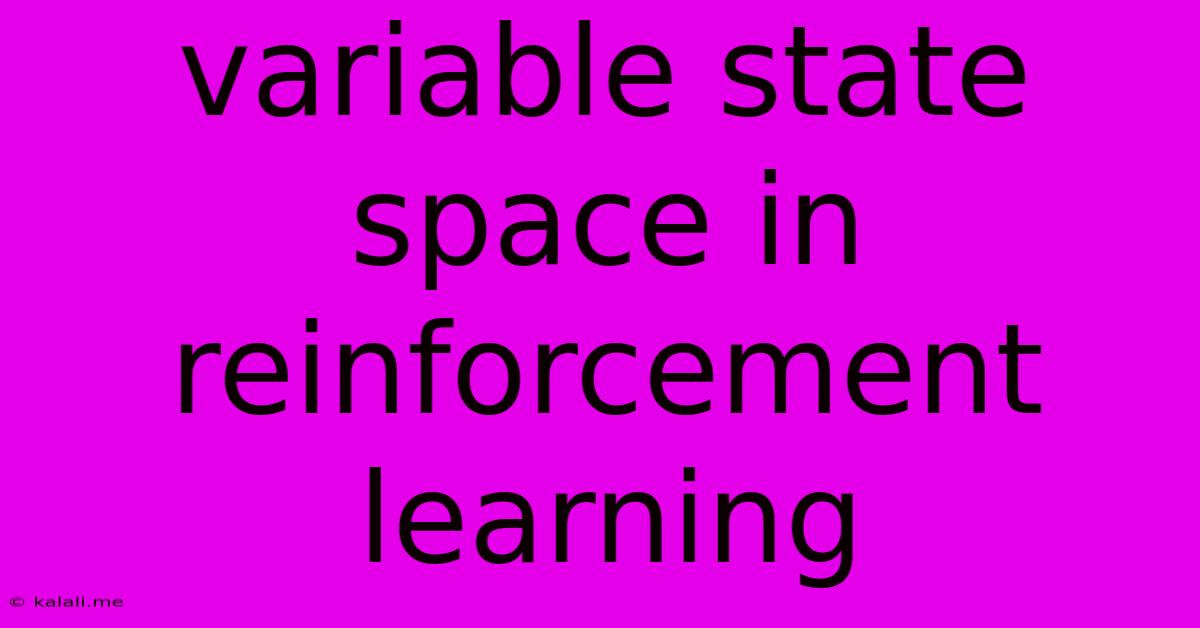Variable State Space In Reinforcement Learning
Kalali
May 23, 2025 · 3 min read

Table of Contents
Variable State Space in Reinforcement Learning: Challenges and Solutions
Reinforcement learning (RL) agents learn optimal policies by interacting with an environment. A crucial aspect of this interaction is the agent's understanding of the environment's state. While many RL algorithms assume a fixed, finite state space, real-world problems often present variable state spaces, posing significant challenges. This article delves into the complexities of variable state spaces in reinforcement learning, exploring the difficulties they introduce and examining strategies for addressing them. This includes discussion of techniques like function approximation, memory-augmented networks, and hierarchical RL.
The core challenge with variable state spaces lies in the agent's inability to pre-define all possible states. This might arise from:
- High-dimensionality: The state might be represented by a large number of continuous or discrete variables, making exhaustive enumeration impossible. Imagine a robot navigating a complex environment; its state could include its precise location, orientation, and the positions of numerous objects.
- Dynamic state space: The set of possible states can change over time. For example, in a game where objects are added or removed, the state space expands or contracts.
- Partially observable environments: The agent might not have access to all relevant information, resulting in an effectively larger state space as it must consider various possibilities based on incomplete observations.
These issues lead to several problems:
- Curse of dimensionality: The computational cost of representing and exploring a high-dimensional state space grows exponentially, rendering many traditional RL algorithms impractical.
- State representation: Finding an effective way to represent the state becomes critical. Poor representation can lead to inefficient learning or poor performance.
- Generalization: The agent needs to generalize its learned policy to unseen states, a difficulty exacerbated by a variable state space.
Strategies for Handling Variable State Spaces
Several techniques are employed to overcome the challenges posed by variable state spaces:
1. Function Approximation
Instead of explicitly representing each state, function approximation uses a parameterized function to estimate the value function or policy. This allows the agent to generalize to unseen states. Common methods include:
- Neural networks: Neural networks are powerful function approximators that can learn complex relationships between states and actions. They are particularly well-suited for high-dimensional state spaces.
- Linear function approximation: This simpler approach uses linear combinations of features to approximate the value function or policy. It's less computationally expensive than neural networks but may struggle with highly complex relationships.
2. Memory-Augmented Networks
These networks augment the standard neural network architecture with external memory components. This allows the agent to store and retrieve relevant information about past states and experiences, effectively expanding its state representation. Examples include:
- Differentiable Neural Computers (DNCs): DNCs combine a neural network with an external memory that can be addressed and manipulated in a flexible way.
- Neural Turing Machines (NTMs): Similar to DNCs, NTMs use an external memory to store and retrieve information, enhancing their capacity to handle complex state spaces.
3. Hierarchical Reinforcement Learning
This approach decomposes the overall task into a hierarchy of subtasks. Each subtask has its own simpler state space and policy. This simplifies the learning process by breaking down the complex problem into more manageable components. This allows for more efficient exploration and learning in complex environments.
4. State Abstraction
This technique involves grouping similar states into abstract states, reducing the size of the effective state space. The key challenge lies in defining meaningful abstractions that preserve the relevant information for decision-making.
Conclusion
Variable state spaces are a significant challenge in reinforcement learning, demanding sophisticated techniques to handle the complexity. By employing function approximation, memory-augmented networks, hierarchical reinforcement learning, and state abstraction, researchers are making progress in extending the reach of RL to a wider range of real-world applications involving dynamic and high-dimensional environments. Further research continues to focus on developing more robust and efficient methods for addressing the challenges presented by variable state spaces, pushing the boundaries of what's possible with reinforcement learning.
Latest Posts
Latest Posts
-
25 Cents A Minute For An Hour
Jun 30, 2025
-
In Music What Does Allegro Mean Math Answer Key Pdf
Jun 30, 2025
-
What Is 1 5 Of A Tablespoon
Jun 30, 2025
-
How Long Does It Take To Drive Through Illinois
Jun 30, 2025
-
If I Was Born In 1988 How Old Am I
Jun 30, 2025
Related Post
Thank you for visiting our website which covers about Variable State Space In Reinforcement Learning . We hope the information provided has been useful to you. Feel free to contact us if you have any questions or need further assistance. See you next time and don't miss to bookmark.